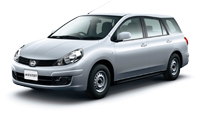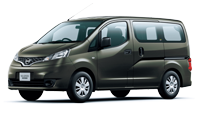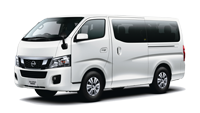Types of Japanese Van
There are roughly four types of vans. The characteristics of each of the four types are explained below.

Two-Box Van
The one called a “Bonnet van (Bon van)” or an “Estate van” has a low vehicle height and a luggage space in the back. It is mainly the station wagon type (a type traditionally called a light van). The maximum loading capacity of this type is 200kg for kei car and 350 – 500kg for registered car (standard size car). While the maximum loading capacity is the smallest among the cargo vans , relatively low fatigue level of passengers and lower vehicle height are its distinctive features.

Fourgonette Van
It is a van with a configuration of a popular car in the front and a large cargo box in the rear, which has been seen in small European cars for a long time. Fourgonnette indicates a box car among the fourgonnette, which is the general name for small cargo vehicles (small trucks) in French, and it is substantially a name for the small bonnet van derived from a popular car.
Since the front half of the passenger vehicle is carried over, it could be an extension of a two-box type. The feature is that only the back part of the vehicle is in a large box shape, and the outside panel of the cabin and the cargo box are connected, which is different from a type in which a panel van type cargo box is installed on a pickup truck. The interior of the driver seat and the cargo compartment are also connected in almost all models.
From its origin, there is the advantage of the driving position and the stability being closer to passenger vehicles compared to the cab over type, but the cab over type is better in space efficiency. Among Japanese cars, there were Mikasa Mark II from Okamura Corporation, Nissan AD MAX , and ALTO_HUSTLE from Suzuki. However, they did not take hold because of the height limit of mechanical parking facilities and the inconvenience of 2 doors, and the Monocorps type described later was already popular widely.

Monospace Van
A monospace commercial vehicle that has the common design with MPV and minivan, or their derivative is seen among the European cars the most. It has a tall cabin and a cargo compartment, and the bonnet is shorter compared to the full length, so it is sometimes called the one and a half-box in Japan.
Almost all of them have a line up of passenger and passenger/cargo combination versions.
There are benefits as good stability, natural driving position, and sufficiently secured crushable zone, but the cargo compartment capacity is compressed because of the benefits.

Monocorps Van
The Monocorps type has a high vehicle height and there is no independent bonnet, so a large floor space can be allocated to the cargo compartment. It is the mainstream in some parts of Asia including Japan due to its superior space efficiency and vehicle operability.On the other hand, it is unfavorable in driving position and front collision safety compared to the style with a bonnet, so Japanese vans of the 2000s or later have a minimum crushable zone and the deformation prevention structure of the cabin.
In the engine mounting position, there is the cab over type that is under the front seat, the semi-cab over type that is under the front seat or in front of the front seat, the midship type that is in the center part of the vehicle body under the floor, and the rear engine type that is behind the rear axle.
In Monocorps type, some models have three rows of seats.














